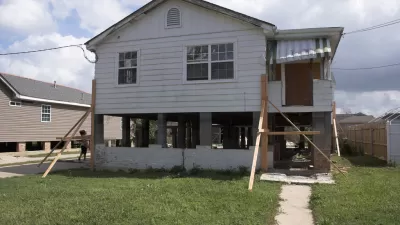2008 saw one of the greatest number of deaths worldwide from natural disasters. Factors contributing to the high number of deaths include extreme weather brought about by climate change, as well as rapid urbanization in vulnerable areas.
"Myanmar's devastating cyclone and central China's earthquake drove up the annual disaster death toll, causing most of the fatalities and making 2008 one of the deadliest years for natural disasters so far this decade, the United Nations said Thursday. At least 235,816 people lost their lives in 321 disasters around the world last year, said the UN International Strategy for Disaster Reduction.
The Intergovernmental Panel on Climate Change has warned that global warming would increase the number of extreme weather events and cause more natural disasters.
Increasing numbers of people living in urban areas increase the risk of deaths when a natural disaster occurs. Environmental degradation and poverty, which exposes poor communities more to natural hazards than better protected wealthier areas, also make it difficult to protect people from disasters."
FULL STORY: 2008 deadly year for natural disasters

Americans May Be Stuck — But Why?
Americans are moving a lot less than they once did, and that is a problem. While Yoni Applebaum, in his highly-publicized article Stuck, gets the reasons badly wrong, it's still important to ask: why are we moving so much less than before?

Using Old Oil and Gas Wells for Green Energy Storage
Penn State researchers have found that repurposing abandoned oil and gas wells for geothermal-assisted compressed-air energy storage can boost efficiency, reduce environmental risks, and support clean energy and job transitions.

Placekeeping: Setting a New Precedent for City Planners
How a preservation-based approach to redevelopment and urban design can prevent displacement and honor legacy communities.

Study: Maui’s Plan to Convert Vacation Rentals to Long-Term Housing Could Cause Nearly $1 Billion Economic Loss
The plan would reduce visitor accommodation by 25,% resulting in 1,900 jobs lost.

Idaho Data: Unexpected Vehicle Repairs Exacerbate Housing Instability, Eviction Risk
Over 21 percent of clients struggle with transportation barriers.

A Year-Long Investigation On Permanent Supportive Housing
The New York Times reveals what’s working and what’s not in the cornerstone of Housing First.
Urban Design for Planners 1: Software Tools
This six-course series explores essential urban design concepts using open source software and equips planners with the tools they need to participate fully in the urban design process.
Planning for Universal Design
Learn the tools for implementing Universal Design in planning regulations.
Heyer Gruel & Associates PA
City of Moreno Valley
Institute for Housing and Urban Development Studies (IHS)
City of Grandview
Harvard GSD Executive Education
Salt Lake City
NYU Wagner Graduate School of Public Service
City of Cambridge, Maryland





























